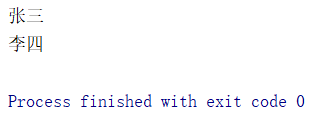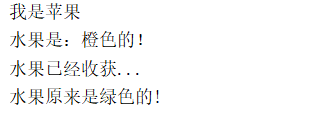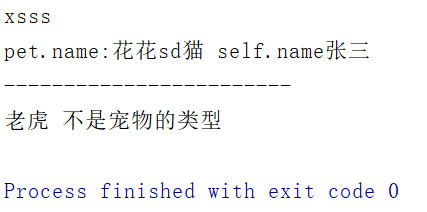1、python类如何调用父类构造函数 __init__ (继承过程中强调父类构造方法)
-方法一: super().__init__
class Father(): def __init__(self): print("张三") class Son(Father): def __init__(self): super().__init__() print("李四")
-方法二: super(自己类名,self).__init__
class Father(): def __init__(self): print("张三") class Son(Father): def __init__(self): super(Son,self).__init__() print("李四")
-方法三: Father.__init__(self)
class Father(): def __init__(self): print("张三") class Son(Father): def __init__(self): Father.__init__(self) print("李四")
打印结果:

2、python类如何调用父类方法 (继承过程中强调父类方法)
super().run()
class Father(): def run(self): print("run") class Son(Father): def run(self): #继承父类的方法 super().run()
3、python子类重写父类的方法 (重写也要先继承)
重写:父类提供的方法不能满足子类的需求,需要在子类中定义一个同名的方法,即为重写
重写构造函数 __init__
class Person(object): def __init__(self, name, age): self.name = name self.age = age self.money = 1000 class Student(Person): def __init__(self, name, age, school): super().__init__(name, age) self.school = school print(str(age)+"那年的"+name+self.school) student=Student("ljf520hj",20,"好想去985")
打印结果:

重写父类的方法,默认搜索原则:先找到当前类,再去找父类
class Person(object): def __init__(self, name, age): self.name = name self.age = age self.money = 1000 def eat(self,food): print("人吃"+food) class Student(Person): def __init__(self, name, age, school): super().__init__(name, age) self.school = school # print(str(age)+"那年的"+name+self.school) def eat(self,food,fruit): super().eat(food) print("学生"+food+fruit) student=Student("ljf520hj",20,"好想去985") student.eat("麻辣烫","水龙果")
打印结果:

4、python私有属性读写
class Student(object): def __init__(self,age): self.__age=age @property def age(self): print("读年龄",self.__age) @age.setter def age(self,age): self.__age=age print("写年龄",self.__age) s= Student(1) s.age=10 print(s.age)
5、继承--类方法继承
class Fruit: color = ‘绿色‘ def harvest(self, color): print(f"水果是:{color}的!") print("水果已经收获...") print(f"水果原来是{Fruit.color}的!") class Apple(Fruit): color = "红色" def __init__(self): print("我是苹果") a=Apple() a.harvest("橙色")
打印结果:

5、继承-构造函数的继承
class Father(object): def __init__(self, name): self.name = name print("name: %s" % (self.name)) def getName(self): return ‘Father ‘ + self.name class Son(Father): def getName(self): return ‘Son ‘ + self.name son=Son("ljf520hj") print(son.getName())
打印结果:

6、封装,继承,多态 先有封装,之后有继承,最后才是多态
class Person(object): def __init__(self,name): self.name = name def feed_pet(self,pet): if isinstance(pet,Pet): print("pet.name:"+str(pet.nickname)+"sd"+str(pet.role),"self.name"+self.name) else: print(pet.role,"不是宠物的类型") class Pet(object): role = ‘Pet‘ def __init__(self,nickname,age): self.nickname = nickname self.age = age def show(self): print(self.nickname,self.age) class Cat(Pet): role="猫" def __init__(self,nickname,age): super().__init__(nickname,age) print("xsss") class Dog(Pet): role="狗" class Tiger(object): role="老虎" cat = Cat("花花",1) tiger = Tiger() person=Person("张三") person.feed_pet(cat) print("------------------------") person.feed_pet(tiger)

原文:https://www.cnblogs.com/ljf520hj/p/14754843.html